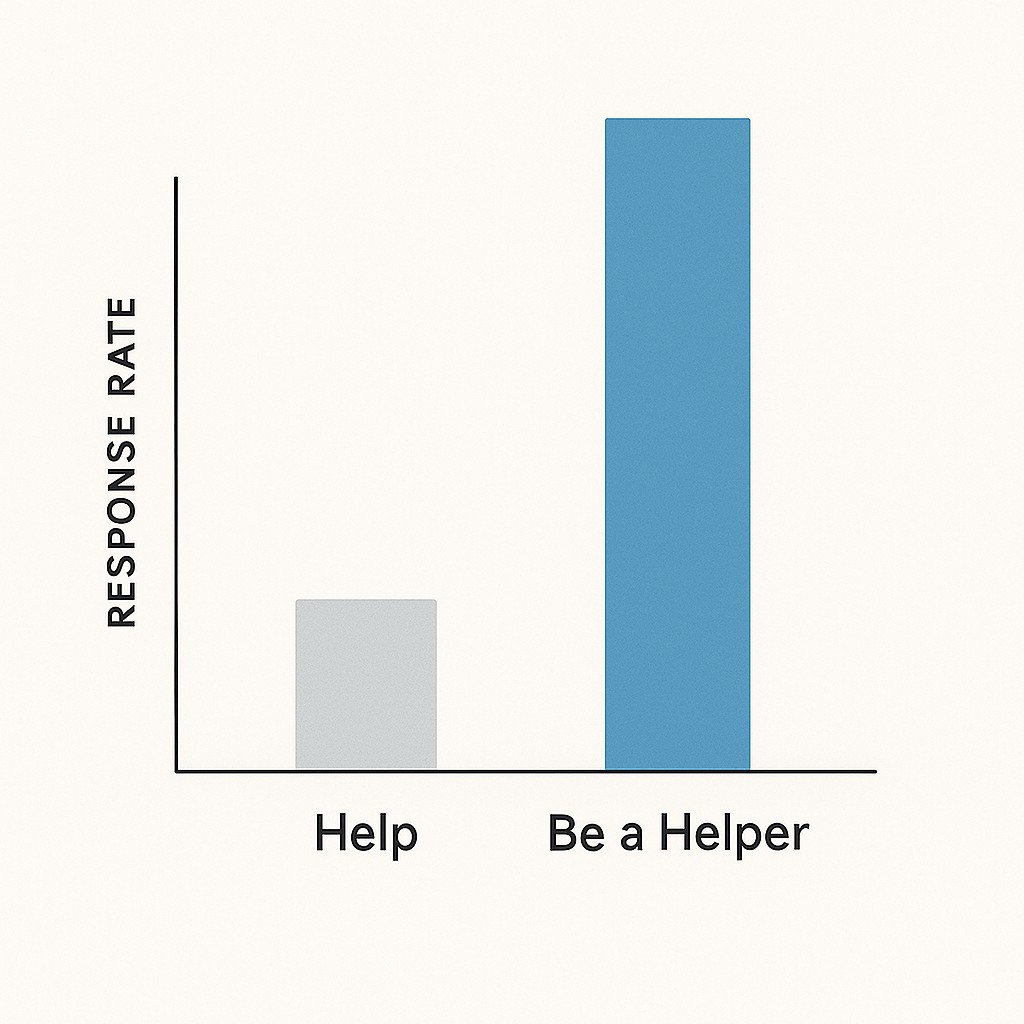Make Engineering Requests Actionable: Structured, Reason-Backed Asks That Build Ownership
Make Engineering Requests Actionable: Structured, Reason-Backed Asks That Build Ownership

Phrasing That Drives Action
Here’s what stopped me cold: just a one-word shift, from “help” to “be a helper,” made kids more likely to act. The twist? Children who heard the noun wording (“helper”) acted more than those who heard the verb version (“help”), showing identity cues really do change behavior. It’s a tiny tweak, but the change in results is anything but small.

If you lead an engineering team, you’ve felt the drag that comes when you don’t make engineering requests actionable. Code is crisp, but our talk about work can get fuzzy fast. For me, it all comes back to clarity. If you don’t say what needs doing, or why, or who owns it, nothing moves. The work sits. We circle.
Here’s the core shift. Treat language like code. Structure your asks and recommendations the way you’d write a good function—explicit names, clear purpose, zero ambiguity. The less you hedge (“maybe we could…”), the more your team trusts the direction. Anchor your requests to identity (“be the reviewer,” “own the interface”), and you’ll see ownership. People move because the ask fits into how they see themselves, not just as another item on the board. This model? Clarity plus identity cues equals action you can rely on.
We’ll get into small, practical shifts you can use right away. Ones that cut through the back-and-forth, reduce guesswork, and build trust in technical teams.
Why Messages Get Ignored—and What Really Drives Action
Engineers, myself included, trust code because syntax calls the shots. There’s a spec to read. You know when you’ve broken a rule. But when we move to messaging—Slack, comments, docs—it feels nebulous, subjective. No contract, no linter for intent. That gap is why so many requests float past with no traction.
Here’s where things break down. Vague asks (“circulate this when you can”), hedging (“maybe consider updating…”), and filler sap energy from the team. You’ve seen it in design review threads that trail off, or in docs riddled with qualifiers that leave everyone guessing. Each time we have to interpret or double-check, it’s extra cognitive load. Tiny taxes that slow us down and make ownership look like a moving target.
Now, flipping language to play on identity isn’t just a clever trick—it’s profoundly powerful, especially in technical work. Say you’re asking someone to fix a bug. “Can you help with this?” gets shrugs and slow walk-ons. But try anchoring what needs doing to who they are. “I know you’re the person to solve this.” That’s different. Suddenly, it’s not just a chore—it’s a fit for their skill, reputation, or role.
There’s hard data here, too. When language anchors action to identity—like asking people to “be a voter” instead of just “vote”—actual follow-through can jump from 82% to 96%. The same effect shows up when you invite an engineer to “own this module” rather than “chip in.” The request clicks into their sense of self, and the work gets done faster and with more care.
Confidence, though, isn’t pretending to know everything or calling shots you can’t back up—it’s choosing to write clear engineering requests. It’s about structuring your ask. Naming what, why, and who, so people know where they stand. Structured requests show that you’re not guessing, and that trust rubs off.
I used to think if I kept my requests casual, the team would appreciate it more. But looking back, I can see how much slower things moved when the asks weren’t anchored. Maybe you worry this sounds manipulative—or just not how engineers talk. I get it. But these tweaks aren’t about tricking anyone. They’re about making intent unavoidable and ownership obvious. Simple, ethical, and they fit tech culture once you feel how much smoother things run.
Language Is Syntax: Testing Phrasing Like Code
I treat word choice like syntax. If a line of code is unclear, I rewrite it. Requests should get that same rigor. You can test how a phrase lands with a teammate. Syntax isn’t just for compilers; it’s for communication.
The schema I rely on is simple: make engineering requests actionable. Lead with your recommendation, lay out the reasoning behind it, and end with a clear next step. This builds structured confidence. You’re not just tossing ideas into the ether—you’re anchoring them with logic, and handing people something they can act on. When you phrase a request like, “Let’s ship after testing because the last regression came from a missed case—can you confirm coverage by noon?” you close the loop between intention and action.
I keep catching myself front-loading disclaimers. “Just a thought, maybe we could…” Early on, I thought it softened feedback, but it just loaded every message with ambiguity. Now I back my asks with a reason and a recommendation. Instead of “not sure if you have time,” I’ll say, “This API could use another pair of eyes given last week’s outage—can you review?” That extra clarity isn’t just for them; it made my own follow-through sharper.
Here’s a messy moment. Yesterday I spent two hours trying to debug why a junior dev kept pushing half-finished code. I pinged him, asked what was up, got vague replies—nothing specific. Turned out he thought “You can push changes when ready” meant he should get work into the repo as soon as possible, even if he wasn’t confident it was deployable. I’d phrased it loosely, trying not to sound demanding. All day I mulled it over. I ended up rewording my requests to say: “Push when you’ve run all tests and you feel ready for review.” Clarity fixed the behavior faster than another feedback session would have.
The cycle’s familiar. I’ll try a new phrasing aimed at actionable engineering communication in design review or a project kickoff. Sometimes in email, sometimes out loud. See what lands, watch for what gets ignored or acted on, and refactor. If the request fizzles, I’ll strip back qualifiers, or add a reasoning cue. It’s debugging, just with human response as the test suite. Give it a week; you’ll spot the patterns. What’s surprising is that once framing cuts down back-and-forth, outputs—whether designs or deploys—stabilize fast. The right phrasing makes action feel straightforward, and suddenly the whole team’s velocity ticks up. You don’t need to overthink it. Just tune the language, see what works, and iterate like you would with any other system.
Make Engineering Requests Actionable: Five Steps for Engineering Leaders
Ready to put all this into action? Here’s how I sharpen requests so they actually drive movement.
Step one is dead simple. Lead with structured engineering recommendations and, in one breath, say why. That’s it. The disclaimers (“just my thoughts,” or “maybe if possible”) can go at the end if you must. Or better yet, drop them. Clarity comes first. Start with what you want and why it matters.
Next, reduce hedging in engineering by stripping out the filler and hedging that clog up channels and stall momentum. If you find yourself typing “uh,” “maybe,” or “just” in Teams threads, docs, or during design reviews, back up and rewrite—what, why, and by when. It’s direct, but also kind. Here’s why it works. Stripping out filler and misaligned cues actually lowers extraneous cognitive load—the unnecessary mental effort that slows people down. People move faster when their brains aren’t wading through word fog.
Step three. Tie your ask to identity—the right person, role, or even pride in work. This isn’t pressure; it’s a nudge. Anchor requests to who someone is (“as the API lead, this is yours,” or “can you be our code reviewer here?”), not just what needs doing. That creates built-in ownership. So the right person moves, not just anyone who happens to see the thread.
Fourth, treat your language like code. Test it. Experiment with phrasing in your requests—try version A in this week’s design review, version B in your next email. Track which actually gets a response (no need for a spreadsheet, just notice trends), and adjust for the next round. Clean syntax wins, even in communication. Each next email gets sharper.
Fifth, measure the impact where it counts. On execution velocity and how often teams get tripped up handing work off. Clarity compiles. Across sprints and reviews, clean asks mean less coordination drag. The lift might feel subtle at first, but week after week, you’ll see it stack up. Remember. Clear language isn’t fluff. It’s leverage.
Bring this mindset everywhere—Teams threads, docs, design reviews. Use names and interfaces that do more than label; they declare responsibility and hint at next steps. “AuthService.reviewedBy” signals who signs off, not just who’s listed. Any interface—whether a function, a doc heading, or a Slack group—can imply real ownership. It’s the difference between a request that lingers and one that moves.
You’ll find, once you start, that most teams crave this kind of structure. No one likes guessing about what’s expected or who owns the hand-off. The irony? It takes less time to speak clearly than to sort out confusion later. The more you anchor your asks, strip the filler, and build in identity, the more the work moves where it should—without extra reminders or last-minute fixes. Try it this week, in one thread or one review. See what shifts.
Turn your structured, reason-backed asks into ready-to-send content, using the app to generate AI-written drafts for Slack, docs, and reviews, aligned to roles, reasoning, and clear next steps.
Practicing Clarity Without Overreach
Shifting phrasing toward identity-based engineering requests isn’t about control. It’s about clarity, rooted in respect. When you anchor asks to who someone is and what they own, you’re helping peers see exactly where their contribution fits and why it matters. It’s not a trick; it’s a signal of trust, and it tightens the link between intention and impact. The goal is to make everyone’s role in the process obvious, so action feels natural, not imposed.
It’s natural to worry that these techniques might feel rigid or come off as dogmatic. The point isn’t to mask uncertainty or bulldoze your team. Structured confidence means you’re firm about what’s needed, but open about how to get there. Most engineers—including me—trust that balance. Strong ask, flexible pathway. If anything, I’ve had to admit how often I used hedge words when a simple, direct line would have worked.
By the way, I still catch myself slipping into old habits, even after years of practice. Sometimes clarity is obvious. Sometimes it’s a moving target I keep chasing. To start, just practice the schema once a day—pick a moment (a Slack ping, a pull request, a comment), anchor the ask, and jot down what landed or didn’t. By capturing these daily insights, clarity shifts from a one-time effort to real muscle memory.
Enjoyed this post? For more insights on engineering leadership, mindful productivity, and navigating the modern workday, follow me on LinkedIn to stay inspired and join the conversation.
